No matter the format and no matter the card text, new cards get compared to old cards. Ixalan‘s River’s Rebuke drew swift comparisons to Cyclonic Rift because they both bounce loads of opposing permanents. They can be used very differently, but the most natural reaction was to compare them directly.
This life cycle can lead to new cards feeling like disappointments for a long time:
1) They get compared to something else, and it’s assumed the new card has homes like the old card; and
2) If they’re put in the wrong home initially, the disappointment keeps people from trying to find other homes for them.
With this article, I intend to spare you that part of the life cycle in Ravnica Allegiance prerelease season and get the more unusual cards straight into the right multiplayer homes – because there are a lot of great ones this time around.
Smothering Tithe

The first-level comparison is to Rhystic Study or Mystic Remora – the enchantment’s controller will usually get what they want because people are unwilling to save mana for it all the time. At that point, Smothering Tithe feels bad, because a shiny new Treasure is not as good as a shiny new card.
Truth be told, Smothering Tithe fills a very different role than Rhystic Study. This is one of the fastest ways to make artifacts that we’ve ever seen in white. White’s been involved with artifacts for awhile, from Esper in Alara block to metalcraft in Scars of Mirrodin, but it’s not a primary artifact color, as last year’s blue-red Exquisite Invention evinced.
Few players are willing to pay two mana for each card they draw, so you’re looking at a couple artifacts every trip around the table – and that’s a big deal. Whether it’s the soft guarantee of metalcraft after a Vandalblast (Jor Kadeen, the Prevailer is excited) or major pump for Master of Etherium, there’s a lot you can do with fast, abundant Treasure. You can even use all that Treasure for permanent mana if you’re playing Inspiring Statuary.
You’re not going to punish card draw with Smothering Tithe, and I don’t know that it will be a reliable way to keep up with Consecrated Sphinx and friends. But it will get you a slop bucket of artifacts, and loads of decks want those. Put in that light, Smothering Tithe is an incredibly interesting card, and I think it will find a home.
Unbreakable Formation
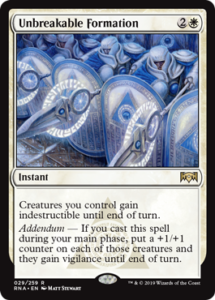
Heroic Intervention is a popular two-mana instant that can grant indestructibility to your team. It’s easy to look at the extra mana required for Unbreakable Formation and the lack of hexproof and say it’s worse. But first, how many times do you play Heroic Intervention for the hexproof? I’ve used it that way before, but it’s the backup case compared to the primary case of saving the team. In that sense, indestructibility is the Plan A use of Heroic Intervention, and hexproof is the Plan B.
With Unbreakable Formation, I’m not certain indestructibility is the Plan A use; I think it’s Plan B. Addendum’s “bonus” wording obscures this point, but casting Unbreakable Formation in one of your main phases is strong in multiplayer. It’s Ajani Goldmane‘s middle ability plus indestructibility, or Song of Freyalise‘s final chapter without the trample. Vigilance is such a big deal in multiplayer because it grants a free, shields-up attack step, and there will be many cases this lets you crunch through an otherwise stalled board.
Moreover, don’t think paying three mana for Unbreakable Formation makes it massively worse than Heroic Intervention. While there is a steep dropoff in multiplayer utility as the mana cost of instants increases, that’s less true for “save-the-team” spells. If an opponent likely has a sweeper, you aren’t using your mana as you would on other turns, because you’re not casting creatures into that sweeper. Rare is the mana-efficient tap-out turn that then meets a sweeper; it happens, but not nearly enough to consider it normal.
If the most relevant part of Heroic Intervention is a card’s Plan B, it’s a playable card; Unbreakable Formation is plenty playable.
Verity Circle

At first blush, Verity Circle reads like it will draw you cards about as often as Runic Armasaur. But unlike Runic Armasaur, which requires opponents to take actions, Verity Circle does the work for you.
Last week, I played against Ensnare in Commander for the first time, and it was a tough card to handle. Verity Circle plus Ensnare is phenomenal, and there are several other ways to draw a huge number of cards. Aboshan, Cephalid Emperor decks will want Verity Circle; Breaching Leviathan wants to join the fun. Cryptic Command‘s tap mode might become even more popular now that it can draw double-digit cards, and Mu Yanling‘s ultimate ability becomes a virtual win on the spot. White has a few of these effects as well, like Aether Shockwave, Dawnglare Invoker, and Subjugator Angel; even green gets Timbermare.
If you really want to get this card going, try Faces of the Past. I like that card already in tribal decks and decks that mess with creature types, but even without that, you can get a lot of free taps in. With Verity Circle, that tapping is no longer gratuitous – it’s game-winning.
Awaken the Erstwhile
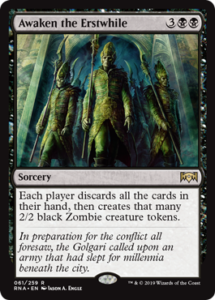
This card’s outcomes differ greatly depending on when you play it. In the early game, when everyone still has roughly the same number of cards in hand, the Zombies aren’t that relevant, meaning it fits on the global-discard curve between Mindslicer and Sire of Insanity. That’s reason enough for several decks to play it.
Later, this might let the player with loads of cards in their hand win quicker. But it might also allow a bunch of players to gang up on someone with a great board position but no cards in hand, or it might just provide tons of creatures so you can trigger Rage Thrower and Vicious Shadows. If you can use both “modes” of Awaken the Erstwhile, you’ve got a potent card.
Rampage of the Clans
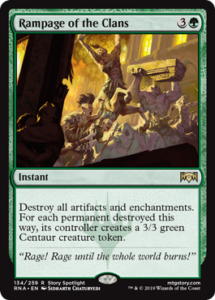
Speaking of cards with pseudo-modes, what’s the optimal use here? Unlike with Awaken the Erstwhile, you’re unlikely to get any creatures yourself in the early game, so all the 3/3’s you just gave to your opponents will turn on you, the open player. But that implies that you want to have a normal-to-heavy mix of artifacts and enchantments in your deck. I have an Arixmethes, Slumbering Isle deck with no other creature cards, but a lot of cards that make creatures or turn into them; it’s enchantment-heavy and might want to run this in response to a Merciless Eviction or Austere Command.
Rampage of the Clans is also a great response to Austere Command. Turn all the artifacts and enchantments you dislike into creatures, and they’re gone! Cards like Hallowed Moonlight (a great anti-reanimator and anti-token card) and Suture Priest can be fun with Rampage of the Clans as well. And don’t rule out the possibility of turning your artifacts and enchantments into Centaurs on an end step after a board wipe!
This isn’t a massive Beast Within or the new, worse Fracturing Gust; it’s a sweeper you might run in decks that have a lot of artifacts and enchantments to switch the game plan when you need to. That’s fascinating to me, and I hope it works as well as I want it to.
Kaya, Orzhov Usurper
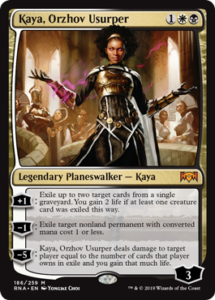
Kaya doesn’t do much on her own in multiplayer, but she has plenty of potential synergies. The plus ability works with decks that want to gain life as many times as possible, such as Karlov of the Ghost Council.
But it’s that ultimate that intrigues me, especially against decks that are otherwise hard to beat. Bojuka Bog, Nihil Spellbomb, and Relic of Progenitus are prevalent in Commander, and delve spells like Dig Through Time and Treasure Cruise show up frequently as well. Turning exiled cards into a liability isn’t something we’ve seen much, and in Kaya‘s case, it kills the player outright.
I have an Anafenza, the Foremost Commander deck where all its removal exiles; Kaya can’t wait to jump in there. Now, you can build an efficient deck with all-exile removal, or close to it. Don’t sleep on the threat that Kaya can represent.
Lavinia, Azorius Renegade
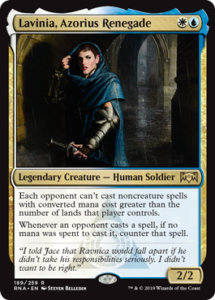
Initially, I thought Lavinia’s ability to shut off mana rocks was the only thing that made her relevant in Commander, and that was enough for me to be interested. But that second ability hits more than I thought it did. It’s easy to read it as dealing with Vintage/Legacy cards like Force of Will and anyone playing cascade.
Here are some Commander-playable cards that wilt under Lavinia‘s second ability:
Aetherworks Marvel
Bring to Light (whatever it tutors for)
Chaos Wand
Diluvian Primordial
Etali, Primal Storm
Isochron Scepter
Jeleva, Nephalia’s Scourge
Mind’s Dilation
Narset, Enlightened Master
Omniscience
Rashmi, Eternities Crafter
Sunbird’s Invocation
Sunforger
Torrential Gearhulk
Villainous Wealth
Yennett, Cryptic Sovereign
Not only is that list pretty long, but those cards are seen in a variety of decks, and many of them are in blue or red decks that aren’t affected by Lavinia‘s first ability. Does that make Lavinia a better hatebear in Commander than, say, Meddling Mage (which always has a commander it can name)? I don’t know. But I’m willing to bet most decks will be affected by one ability or the other, and that’s enough for me to give Lavinia a chance.
Conclusion
I’ve barely scratched the surface of what Ravnica Allegiance has in store for multiplayer enthusiasts. Hopefully, this kind of analysis not only helps you with these cards, but the other cards coming out. It feels like there are a lot more puzzlers in this set than there have been in awhile, and I love that. Whatever you love from this set, I hope you open it in your prereleases and boosters soon!

Brandon Isleib plays a lot of Commander and Brawl and loves finding the intersection of unusual and effective plays. He worked for Wizards of the Coast in 2014, he has put flavor text on a few cards, and he’s partly responsible for “create” being the word for cards making tokens. He is a legislation editor for the city of Seattle, he has written a baseball book, and he is proficient at making his bio sound more impressive than it is.

